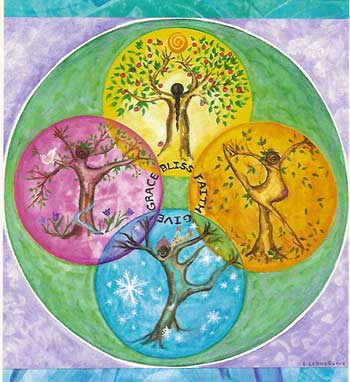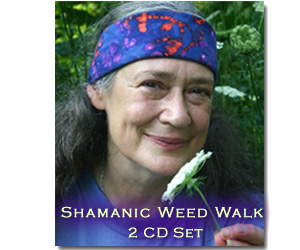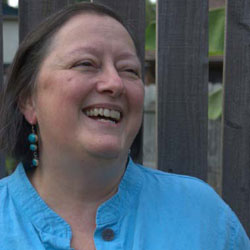Review of “Shamanic Weed Walk”
An intensive given by Susun Weed at Green Nations Conference - 2001
c 2010 Review by Jan Calloway-Baxter
mentor at the Wise Woman School
2 CD set Shamanic Weed Walk
The plants, as Susun points out, are rather obviously grounded, so the more grounded you are, the more in tune with the plants you will be. Part of grounding yourself is gathering information.
The information provided here by Susun to her class at the 2001 Green Nations  Gathering to help prepare them for their own group and individual Shamanic Weed Walks will give you a model within which you can place any plant you encounter. Once you have found its correct placement on the wheel, you can begin to understand the plant and to discover the gifts it has to bring to you.
Gathering to help prepare them for their own group and individual Shamanic Weed Walks will give you a model within which you can place any plant you encounter. Once you have found its correct placement on the wheel, you can begin to understand the plant and to discover the gifts it has to bring to you.
In this class, Susun explains her Medicine Wheel of plant uses, pointing out that her wheel is orally-fixated and does not include the many important uses of plants in other ways such as fibers, firewood, building materials, and aesthetics.
This CD makes you long to see the blackboard Susun is drawing on. As I listened, I drew my own medicine wheel, sticking plants in willy nilly as she went on to describe their places in the North, East, South or West and the points in between. If you plan to follow me in this, I suggest quite a nice LARGE sheet of paper!
Do you know the difference between a circle and a wheel? A wheel moves. The moving energy of the medicine wheel of plants that Susun envisions is based on the Dakota name “Wakantonka,” mis-translated by white people as the Great Spirit when its meaning, according to Susun, is closer to “mysterious movement of energy.”
“Wakan” is often translated as sacred or holy. The sacred moving energy of the plants is what Susun places on her Medicine Wheel.
This Medicine Wheel of plant uses does not follow any specific tradition except Susun’s. So if you have an idea already, complete with correspondences, about what a Medicine Wheel is, you may have to let go of some of those ideas temporarily in order to learn about plants in this way.
Each of the four cardinal points on the wheel represents a type of plant. In the east, we have the sweet, bland taste of food plants like mother’s milk or grain. We are “hardwired” to seek sweet, says Susun. People who wail about their desire for sweets and wish to get rid of that craving are out of luck. Because the sweet of mother’s milk means LIFE.
The south brings us plants that provide minerals, the salty plants such as seaweed. Building on the idea of life represented by the plants of the east, the plants of the south represent the energy of reproduction, of passion. No longer just living, but flourishing.
The west represents those plants that are bitter, poison. Coffee, peppers and mushrooms all belong on this part of the wheel. Susun also places drugs in this area of the wheel—including herbs powdered and put into capsules.
The north provides the exciting tastes of what we often call seasoning plants, spices and oils, the supermarket herbs. This is the place of wisdom on the wheel since wisdom is required to use these plants well.
After talking about these points on the wheel, Susun goes around the wheel again, placing plants in between the cardinal points until her class had a strong understanding of what the places on the wheel represent. Then, they went for a walk.
We, unfortunately, had to stay in the classroom while they went outside, chose a plant to sit with, and sat with it for a while, tasting it and talking to it. Happily, Susun describes to us briefly the plants the group looked at as a whole—dock, goldenrod, mullein—and then we get to listen as the participants talk about their own experiences with the plants and how the medicine wheel helped them to understand what the plant had to offer.
It’s not as much fun as taking a walk with Susun, but listening to this CD is certainly a good second choice.
© 2010 Jan Calloway Baxter
read other reviews by Jan Baxter
Optimum Nutrition - Review by Jan Calloway-Baxter
Herbal Healing for Women - Review by Jan Calloway-Baxter
Magical Plants - Review by Jan Calloway-Baxter
Elements of Herbalism: Harvesting - Review by Jan Calloway-Baxter
The Visionary Art of Martina Hoffmann - Review by Jan Calloway-Baxter





